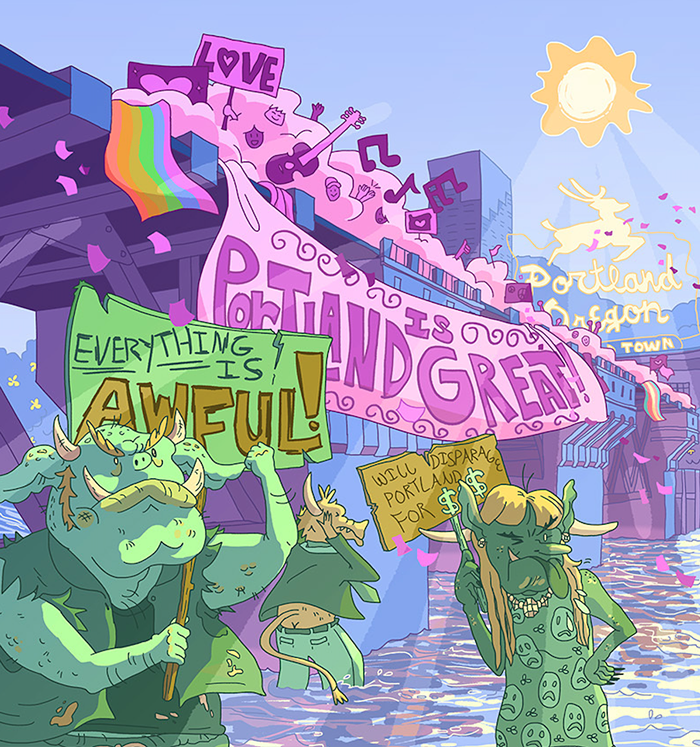ONE THOUSAND AND ONE bunkers line the road to Hermiston, Oregon. Technically, they're called "igloos," but "bunkers" seems more appropriate, given they were built to house 3,717 tons of chemical weapons. Either way, they look like giant graves on the high desert landscape.
Since 1941, the little town of Hermiston has sat on the edge of this field of weapons of mass destruction (WMDs). This fall, all its chemical weapons will be gone. Over the past seven years, canisters loaded with enough mustard, Sarin, and nerve gas to wipe out the nation have been incinerated one by one out here amid the sagebrush and watermelon fields.
So how does it feel to have WMDs as a neighbor all your life?
"We never even gave it a thought," says Frank Harkenrider, 84, who was Hermiston's mayor for 10 years. "Never worried about it. Even when it did blow up once, we didn't worry about it."
Carefree Living in the Shadow Of WMDs
Harkenrider is an old-timer, that's for sure.
Sitting in a diner that smells like a mop, with a jaunty Hermiston, Oregon, baseball cap on his head and a wide smile on his face, Harkenrider recalls his lifelong relationship with the local storage depot for 12 percent of America's chemical weapons.
He remembers when the US Army's Umatilla Ordnance Depot was first built, back in 1941, how Hermiston grew from a sleepy town of 800 to a tent city home to 8,000. When an igloo exploded three years later, killing six workers, Harkenrider was downtown at the movie theater, where the blast blew out the windows. His first job, as a high school freshman, was pitchforking hay out of a donkey-drawn cart onto weapons bunkers to disguise them. During the 40 years Harkenrider has served on Hermiston's city council, the town has grown next to the massive stockpile and employed many of his friends and relatives.
Since the incineration of the weapons began, the depot installed 42 alarm sirens around the region, distributed 18,000 emergency radios to homes and businesses, and handed out "shelter-in-place" boxes including a tiny tarp and duct tape that citizens are supposed to use to turn their bathrooms into airtight shelters.
But instead of being nervous about the depot's lethal potential, old-timers in Hermiston are nostalgic for its passing.
"There's no doubt it will be missed," says Harkenrider.
"There were good dances out there," says Lela Olson, who lived in a tent with her parents for two years while they helped build the depot, later working there herself, and now sits wearing bright red lipstick and nails, squeezed into the diner booth next to Harkenrider. "We all knew that this was going to happen, but part of me hates to see it leave. It's part of your life."
"Weren't you ever scared of it blowing up or leaking nerve gas into the air?" I asked, sipping coffee.
"People didn't think anything about it. We did what we were there to do. Everything was to help our troops," says Olson. "You're from Portland, right?" I nod. She smiles. "That's it," she says. "We're used to it out here. We never think about the thing being dangerous."
Next door at Our Place coffee shop, 54-year-old Linda Phillips is equally nonchalant.
"I didn't really think about it. It's just here. I didn't put it here, but here it is and now we have to deal with it," says Phillips, who worked at the depot briefly before starting her downtown café. "We could live in LA and have earthquakes. We could live in Arkansas and have tornadoes. Which we did. One killed my horse."
Despite its humble character, this little place has played a big role in an international discussion of supreme importance: Once we decide weapons of mass destruction are a bad idea for humanity, how the hell do we get actually rid of them?
Creating, Then Destroying, Our Weapons
The United States began developing chemical weapons back during World War I. Mustard gas killed an estimated 100,000 soldiers and civilians during the war, and immediately after the carnage, the 1925 Geneva Convention bound countries to never again use chemical weapons. But countries didn't agree to never research or produce them. The United States and Soviet Union went right ahead creating more and more chemical weapons, each more advanced than the last. Seven countries—Russia, the US, South Korea, India, Libya, Albania, and Iraq—have now declared chemical weapons stockpiles totaling 72,000 tons.
Governments have not always handled these deadly weapons with care. Albania discovered their 16-ton stockpile in a garage after the Soviet Union broke apart. Until the 1960s, the US military had the habit of burying unwanted chemical weapons or dumping them out into lakes and oceans—in 1993, for example, workers digging a ditch in a ritzy Washington, DC, neighborhood accidentally discovered a cache of WWI-era chemical weapons buried in the backyard of the home of the South Korean ambassador. Across the country, there are currently 200 known chemical weapons dumpsites.
Some stockpiles around the world are closely guarded secrets—such as the purported weapons of mass destruction George W. Bush set out to find when he pushed to invade Iraq in 2003.
While the United States and Soviet Union couldn't agree on much during the Cold War, by the mid-1980s the frosty superpowers agreed they should get rid of their chemical weapons stockpiles.
"For a long time, chemical weapons had really been identified as an inhumane, indiscriminate, abhorrent type of warfare," explains Paul Walker, a chemical weapons policy expert at think tank Global Green. Morals aside, the deadly gas bombs were expensive to produce, dangerous to store, and, actually, not that good as weapons.
"What they proved to be was a weapon that could kill a lot of people, but wasn't really useful in war," says John Isaacs, executive director of the Center for Arms Control. "The weapons depend a lot on the way the wind is blowing."
Some military leaders joined with forward-thinking senators of the Reagan era—including Oregon's late Mark O. Hatfield—to strike a chemical-weapons-reduction pact with the Soviet Union in 1989. Then came the hard part.
"No one really knew what to do with these weapons," says Walker. "No one ever dreamed it would cost so much and be so dangerous to destroy these stockpiles." In 1997, the US and nearly 100 other countries ratified the Chemical Weapons Convention, which agreed that "for the sake of all mankind," all chemical weapons should be destroyed.
Ridding ourselves of our destructive creations was supposed to take 10 years and cost about $1.3 billion. Instead, it is now planned to take 24 years and cost $35 billion, according to Walker.
The United States constructed destruction facilities at each of its nine chemical weapons storage depots and in 2004, the Umatilla Chemical Depot began incinerating the weapons it had so carefully stored for decades.
The weapons canisters are broken apart by robots, drained of lethal chemicals, and burned at 2,700 degrees Fahrenheit. The process is supposed to destroy 99.999 percent of the poison gasses, a statistic the Sierra Club and a group of local residents contested with a lawsuit in 2002. A judge eventually threw out their suit.
Within the lifetime of one generation, our country will have created an entirely new class of weapons, produced a mountain of them, and then destroyed them all. The financial cost for this epic waste of energy is incalculable. But in the end, it's an uplifting sign for the human race.
As John Isaacs says: "The fact that we have banned an entire category of weapons is a step forward for civilization."
We Didn't Even Use 'Em Once!
Most people in Hermiston seem to care less about their local WMD depot than the policy wonks in far-off Washington, DC.
Milt Casper worked as a surety officer for the depot in 1969, when Governor Tom McCall, thanks to a new federal law, first found out that the weapons existed within Oregon's borders. All hell broke loose around the state, but Casper has a scrapbook of newspaper clippings from the time showcasing Hermiston's nonchalance.
"Hermiston Residents Unconcerned about Toxic Munitions," read a headline in the Lewiston Tribune, continuing, "This small Oregon town is a scant five miles from where the gas will be stored [yet] the reaction is one of dead calm."
A survey of the state showed residents around Oregon were eight to one against bringing any new chemical weapons to Oregon, but within Hermiston, a majority was for it. Years later, a mid-'90s survey revealed that half of the area residents did not even know there was an army depot in the area.
Yes, there are environmental concerns and the potential of complete and sudden annihilation (only a four in one million chance, according to the Army statistics), but overall, the Umatilla Chemical Depot has been good to Hermiston.
The environmental issues stem from the leaky gas containers and the potential toxins released into the air through incineration. Since 1984, the weapons at the depot have leaked a recorded 190 times, releasing a few parts per trillion of deadly gas into the igloos.
But there's never been a supported link between health problems in the community and the depot itself, unlike the much larger health issues affecting residents downwind of the Hanford nuclear plant just a few towns over.
Except for the igloo that collapsed in 1944, the thousands of tons of chemical weapons at the depot have never caused a single fatality at war or at home.
In contrast, everyone has felt the economic payoff in Hermiston. The incineration project has pumped $3 billion in federal money into the area and the depot now employs 1,160 people, 660 of whom are Oregon residents. Rather than raging in debates over chemical weapons policy, most Hermiston residents are more concerned with the current practical considerations of what will happen to laid off workers and the 20,000 acres of land the depot will leave empty when it fully closes in five years.
As café owner Linda Phillips' mom Louise Johnson notes: "They were here for 80 years and we didn't even use 'em once!"













